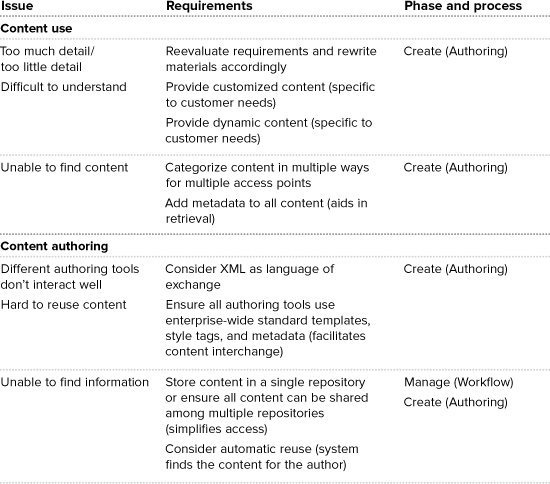Chapter 11. Envisioning your unified content strategy and lifecycle
Armed with your findings from the substantive audit, you can define a vision for your unified content strategy. Remember that the strategy consists of front stage—the customer-facing unified content strategy—and back stage—the unified content lifecycle (processes and technology) that supports your unified content strategy.
When you envision your unified content strategy, you are identifying:
• What types of content your customer needs.
• What format or media they need it in.
• When they need the content.
Your new content lifecycle describes the processes as you would like to see them implemented.
This chapter describes some of the common challenges uncovered during the initial analyses of the content lifecycle and content, and identifies how those issues should be addressed in a new content lifecycle.
The unified content strategy
You need to determine:
• What information products will you provide?
• Why do you have to provide them?
• What needs will they meet?
• How will they be used?
• How is one information product related to another information product?
A good way to determine your information product requirements is to build scenarios for each of your personas and identify the content requirements at each point in the scenario.
Scenarios
One of the best ways to begin the envisioning process is by creating customer scenarios based on your personas. A scenario is a description of an everyday situation. A scenario needs to answer the following questions:
• Who is the person involved?
• What triggers the experience?
• What happens?
• What is the result?
The scenario helps you determine what types of content your customers will need to reach their goals.
The customer content lifecycle and content matrix
Customers go through a variety of stages when they interact with your company and your content. They need different content at different stages. Typical stages (see Figure 11.1) include explore, buy, use, and maintain.
Figure 11.1. Customer content lifecycle.
You need to match the customer content lifecycle phase with the types of content the customer requires to reach the goals of that scenario. This is called a content matrix.
Develop multiple scenarios for all your customer personas to better detail your content matrix.
The unified content lifecycle
The success of a unified content strategy is dependent on the processes you put in place to manage it. Those processes are your unified content lifecycle.
A unified content lifecycle can be implemented in a number of ways, depending on the needs of the organization. No two organizations have the same needs, the same budget, the same goals, or the same culture. Everything you’ve discovered about your company, your goals, and your issues is used to design a unified content lifecycle that will work for you.
Refer to Chapter 14, “Designing workflow” and Chapter 20, “The role of content management” for more information on the processes for managing your content.
Addressing challenges
Your new content lifecycle should address the challenges in your organization—issues that you identified during your analyses of processes and content. Table 11.1 shows some common issues, their requirements in a unified content lifecycle, and the phase where the challenge should be addressed. Challenges are grouped into categories such as issues related to content use, content authoring, localization, and so on.
Table 11.1. Identifying how issues can be addressed



Summary
Before you can begin the design process, you need to develop a vision for your unified content strategy and supporting lifecycle.
Customers go through a variety of stages when they interact with your company and your content. Each stage can have different requirements. Develop a customer content lifecycle based on your customer requirements. A typical content lifecycle includes the explore phase, the buy phase, the use phase, and the maintain phase.
Develop scenarios to identify a typical customer activity. Each scenario helps you determine what types of content your customer will need in order to reach the goals of that scenario. Develop multiple scenarios to ensure that you understand the complete set of customer content requirements. Match the scenarios to the customer stages and develop a content matrix that identifies what information products are required for each phase for a particular customer.
Develop a vision for your unified content lifecycle, explaining to your stakeholders how content will be managed throughout the content lifecycle.


